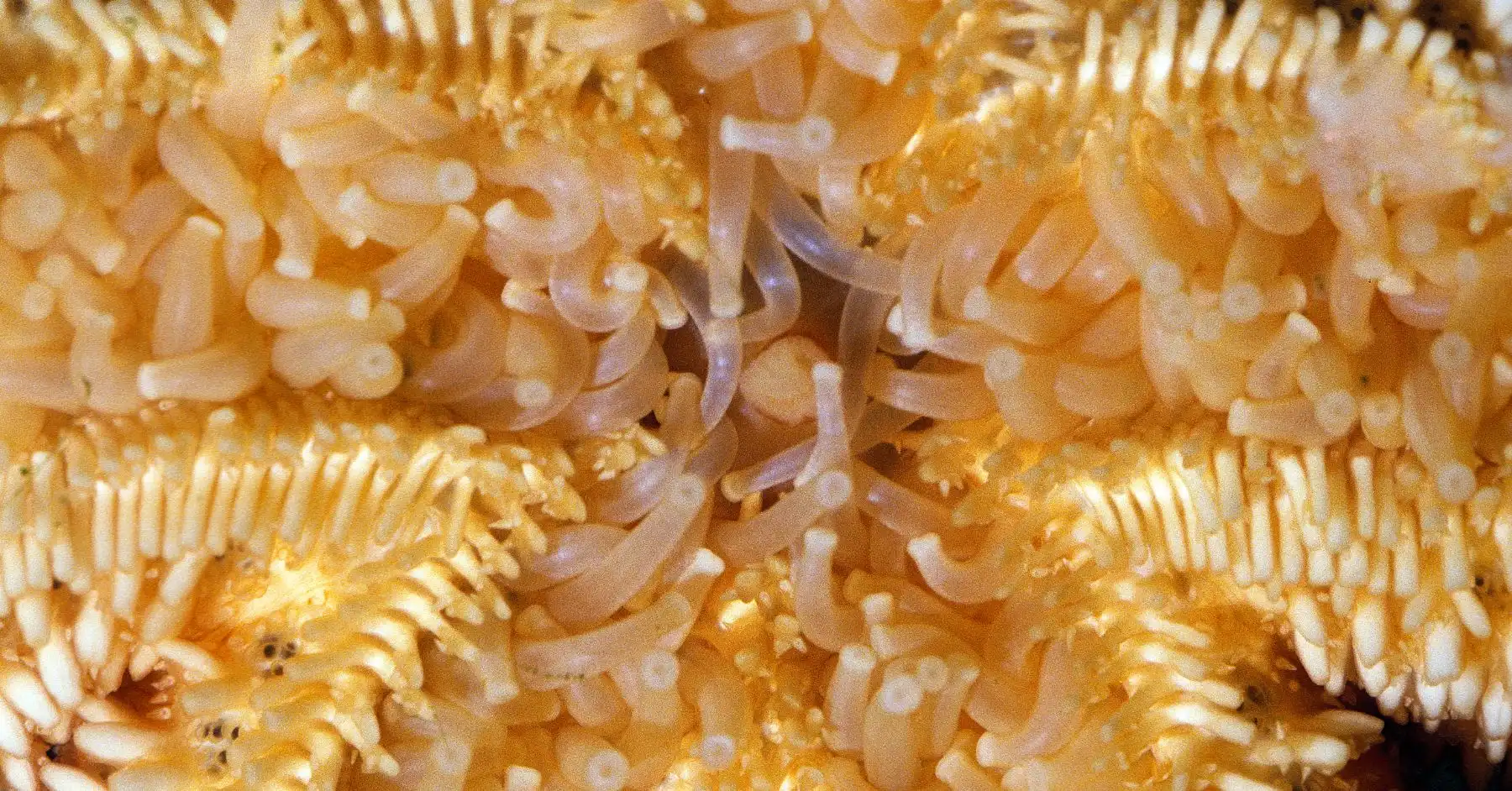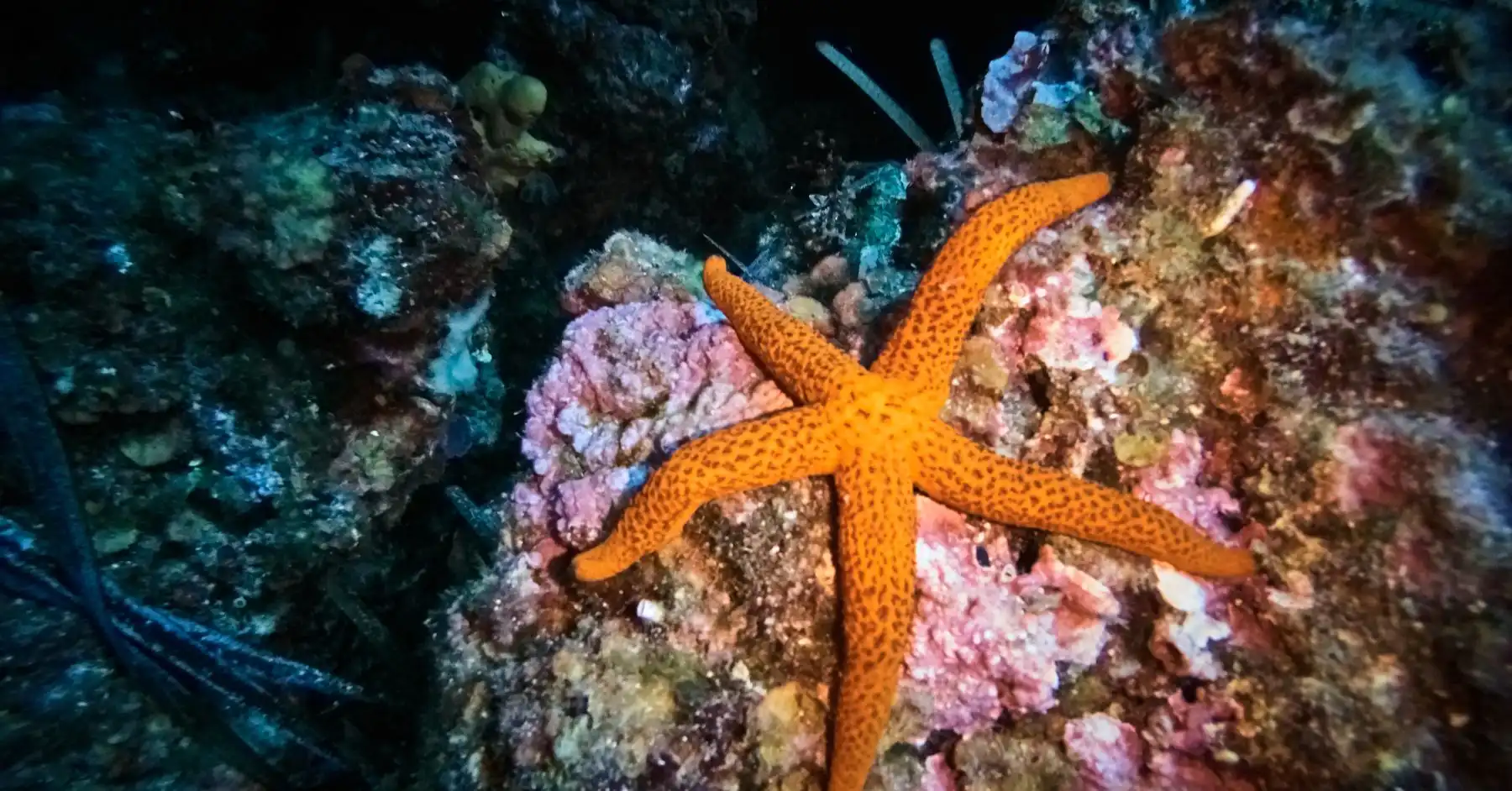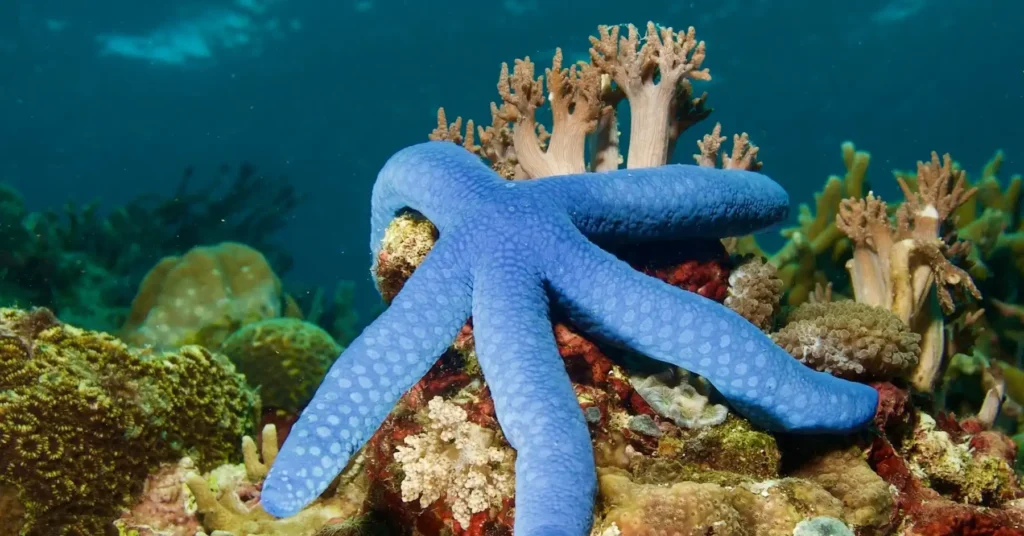Starfish, also known as sea stars, are not fish. They’re spiny-skinned animals called echinoderms. Starfish have tube feet that help them move and capture prey. Some starfish have more than 20 arms covered in tiny suction cups. They have a unique way of eating. Their stomach can come out through their mouth, so they can ingest food they couldn’t otherwise reach. This stomach is able to digest food outside the body and then bring it back in through the mouth.
In some species, this process can be very slow. Their digestive enzymes are released onto the food and over time, break it down into a nutritious liquid. The starfish then sucks this up as a meal! Some species of starfish do not even use their stomachs to eat. They use their suction feeding method to trap small prey like plankton or molluscs and then push them into their mouths with their tube feet.
Most starfish live on the sea bottom and prey on mollusks by prying open their shells. Some starfish have the ability to extend their stomachs out of their bodies and into an animal’s shell, digesting the animal and then withdrawing the stomach back into their bodies.
Starfish have no brain, but they do have nerves that run along their arms and can detect light and chemicals. A ring of nerves runs around their mouth, allowing them to detect taste, while a nerve net allows them to sense touch.

Types of Starfish According to Their Eating Methods
There are many types of starfish. They are divided into different categories according to their eating methods. Some eat by using their arms to grab small bits of food and push it into their central mouth. Others use their tube feet to catch food and bring it back for eating. Still others use their tube feet to hold a mussel or other bivalve shell down until the shell cracks and pops open, allowing them to reach inside for the soft parts of the mollusk.
There are different types of starfish according to their eating methods:
Plate-eating starfish
The plate-eating sea stars are called Asterodiscidaria. They are similar to asteroids in many ways, but differ in the fact that they use plates embedded within their skin for defense rather than spines. The plates cover their dorsal surface, giving them a more solid appearance than other Asteroids. They also tend to be a little flatter.
This group includes species such as Linckia laevigata which is commonly sold in pet stores as Blue Linckia or Comet Sea Star as well as Linkkia multifora which appears more orange in color than the blue of Linckia laevigata.
Coral-eating starfish
These eat coral and the species includes Acanthaster planci, otherwise known as Crown of Thorns Starfish. They are one of the largest sea stars around, with arms reaching at least 60cm and they can have up to 21 arms.
They use their tube feet to move along the coral reef until they find an area that looks like it needs some cleaning up and then they chow down on it!
Predatory Sea Stars
Some sea stars prefer to catch their meals rather than scavenge for them. These predatory sea stars eat other invertebrates including clams, snails and sponges. The crown-of-thorns sea star, Acanthaster planci, is one of the most destructive predators in coral reefs.
They use their tube feet to hold onto prey and then flip their stomachs inside out to secrete enzymes that break down their victim’s flesh. Once their digestive juices have done their work, they use their mouths to suck up the liquefied remains of their meal.
Parasitic Sea Stars
There are a few species of parasitic sea stars, which attach themselves to the outside of a host animal such as a clam or oyster, and eat it alive over the course of several weeks.
Parasitic sea stars are mostly blind and very small, but they have an extremely long digestive tract that allows them to absorb nutrients from the body of their host without damaging its internal tissue or organs.
Filter-Feeding Sea Stars
Filter-feeding sea stars sift tiny food particles out of the water using either their tube feet or special filter-feeding structures near their mouth. While most species of filter-feeding sea stars are harmless scavengers, one particular filter-feeding species is considered invasive because it preys on valuable oyster beds along the coasts of North America and Europe.
They use mucus from glands all over their body to help them trap more food particles as well as protect themselves from predators like crabs.
Carnivorous Sea Stars
Others have evolved to feed on organisms such as fish and worms by using suction to capture their prey. These carnivorous sea stars are found in shallow waters where they can easily find food in the form of small fish or bottom-dwelling invertebrates.
These use their tube feets to grab onto prey, then extrude stomach out through their mouth to begin digesting the prey. Some sea stars may even be able to wrap their arms around large prey such as clams or oysters and pries them open with their spines before consuming them with their stomachs.
Omnivorous Sea Star
These animals eat anything they can get their hands on. They will eat algae, waste products, clams, snails, dead fish, and other small things that get in their path. Their stomachs are also able to digest food outside of their bodies.
This means they can stab a shellfish with their stomach and not have to worry about bringing the entire animal into their mouth. The omnivorous sea star is able to survive on plant material or meat depending on its surroundings. When these animals settle into a home where there is plenty of food available they will grow larger than other starfish because they do not need to move around very much in search of food.
Detritivore Sea Star
Detritivores are very similar to omnivores because they eat just about anything that is already dead or has been left behind by other animals. They find food by smelling it out and then using their tube feet to pull it closer to them so they can devour it with their mouths.The largest type of sea star is detritivore, which grow up to three feet across.
They feed on decaying plant matter or other organic debris that drifts along the ocean floor. Some detritivore sea stars have specialized food capturing structures called pedicellariae.
Asteroids with Specialized Mouths
Some sea stars have evolved a specialized mouth that has a long, protruding proboscis attached to it, which allows them to reach into crevices or into shells that may otherwise be unreachable. This is the case with species such as the grey starfish (Astropecten spp.) and leather star (Dermasterias imbricata), both found in the temperate and tropical waters of the Indo-Pacific region.
Overall different species of starfish have evolved different ways to capture and eat prey. Some starfish wait for prey to pass by, then reach out and grab it with their tube feet. Others creep up on prey and pounce, while others lay in wait, buried under the sand or mud until food passes by. Some species of starfish are capable of detaching one or more arms if they’re not fast enough to avoid being caught by a predator. The arm will continue moving around as if it were still attached to the starfish as it tries to find its way back home. This can happen so quickly that many predators are fooled into thinking the arm is just another meal!

How do starfish eat in the Ocean?
Starfish are found in almost every part of the ocean. They can be found anywhere from the shoreline to the deepest parts of the ocean. Starfish inhabit tropical waters as well as cold water. They are most populous in areas where there is plenty of food, such as kelp forests and coral reefs.
In the ocean generally, starfish eating method is predatory. They are carnivorous, and prey on other invertebrates including oysters, clams, mussels, sea urchins and snails. Starfish can be very large predators in their native habitat. Some species of starfish may reach a diameter of three feet (1 meter) or more and have been observed to eat an entire scallop or oyster within ten minutes.
The mouth of a starfish is located at the center of its underside. The mouth opens into a short food canal that leads to the stomach, which occupies most of the disc and arms. The stomach can evert (turn inside out) so that it protrudes from the mouth and surrounds its prey. Enzymes are secreted by a groove in the stomach wall and begin digesting the prey externally while it is being held by the tube feet. After digestion, waste passes into another groove leading to an anus on the upper surface between two of the arms.
How do starfish eat in Home Aquarium?
Three species of starfish are commonly seen in home aquariums: Chocolate Chip, Fromia, and Linkia. Each species has a different feeding preference. Mostly Starfish are most active at night and will feed on almost any food they can find. They scavenge the bottom of the tank and may even prey on mollusks, crustaceans, or other echinoderms.
Aquarium owners vary as to whether they consider starfish appropriate for home tanks. A majority of aquarium experts advise against keeping them because many species are capable of reproducing rapidly in captivity and can decimate populations of other invertebrates in home tanks.
Starfish requires a diet of live food that is difficult to provide without a natural reef or an established food chain in the tank. Starfish need live foods to thrive in captivity. Most species of starfish eat mussels, clams, snails, and other mollusks found on the ocean floor. Starfish will also eat shrimp and fish if they are available. The starfish use their tube feet to slowly encircle the prey before slowly pulling it apart with their arms and sucking out the body parts inside.
Starfish that have not eaten recently may be lethargic and unresponsive as a result of starvation. Feeding starfish should help them regain energy and movement within 24 hours. If you notice that your starfish is listless, or it is not moving at all, it could be a sign that the starfish hasn’t eaten in a while. Starfish that are not eating usually go through a period of atrophy (a state of malnutrition and inactivity).
A healthy starfish will be able to quickly move away from you when you attempt to touch it. If your starfish does not move away, it could be a sign that it is starving or ill. You can try to feed the starfish if you think this is the case.
As an aquarist, it is your duty to provide the nutrition necessary for them to thrive. Starfish in your aquarium will eat just about anything. The diet of a starfish depends on its type. Most species of starfish are omnivores that feed on both plants and meat. Others are strictly carnivores or herbivores. Some starfish eat corals, clams and other shellfish. Others feed on phytoplankton, sponges and dead fish. They usually live near the shore at the bottom of shallow waters, so they don’t have to swim very far to find their prey.

Related FAQs
How do starfish eat without a brain?
Starfish eating involves a combination of the creature’s nervous system, cardiac stomach, and water vascular system.
The nervous system regulates food digestion. The cardiac stomach, which is inside its body, emits enzymes to break down food. The water vascular system moves food particles into the starfish’s mouth.
How do sea stars eat clams?
First, it forces open the clam shell with its powerful arms, then it everts (turns inside out) its stomach through its mouth and into the clam. The stomach walls secrete digestive enzymes that dissolve the clam’s muscle tissue, which is then sucked into the starfish’s body by way of its stomach.
Where is a starfish’s mouth?
The mouth of a starfish is located on the bottom of its body and is called an oral surface. A tube-like structure, called an oesophagus, extends from the mouth to the stomach.
The stomach of a starfish lies between the madreporite and central disc, and extends out into each arm. The mouth of a starfish is located on the ventral surface (or underside) of its body, typically in the centre. The mouth is surrounded by a ring of small calcareous plates called ossicles. If you want to look at a starfish’s mouth, think about how it moves. The bottom of the starfish is flat, and the top has five sections. Each section has a tube foot at the end of it that helps the starfish move along.
Can a starfish bite you?
Most starfish cannot hurt humans. They have hundreds of small tube feet on the underside of their arms which they use to move and to feed. These tube feet are armed with many tiny, sharp ‘teeth’ called pedicellariae. They do have a mild toxin in their bodies that deters predators and is used to kill their prey. However, if you were to touch or swallow a starfish, it would not poison you. There are several deadly species of pufferfish, though they do not look like the average person’s idea of a fish.
Do starfish have teeth?
Starfish do not have teeth, but they do have hundreds of small suction cups on the ends of their arms that allow them to grip prey. A number of species use their flexible arms to surround a clam or other shellfish and then pry it open by pushing the two sides apart. Others insert the tips of their arms into a hole in the shell and force it open with their powerful muscles.
Starfish don’t use teeth to chew their food, nor do they have stomachs to digest it. They simply push their stomachs outside their bodies and engulf prey with them.
How Do starfish eat without eyes?
One of the most interesting starfish facts is that despite having no eyes, they can see. They don’t have any type of eye but use special light-sensitive cells on their arms to figure out food’s location. Starfish feed on mollusks like clams and oysters. They also eat plankton they filter from the water.
When it comes to eating, starfish don’t have any eyes to guide their food to their mouths. But that doesn’t mean they’re not voracious predators. Some starfish also have hundreds of tube feet on their underside which help them smell, taste and move around. While some starfish eat small fish, mussels and other sea creatures, most starfish are scavengers and eat clams, oysters and dead animals they find on the ocean floor. So starfish do not have eyes, but they do have light-sensitive eye spots at the ends of each arm which allow them to tell light from dark. This helps them know when they’re in danger.
